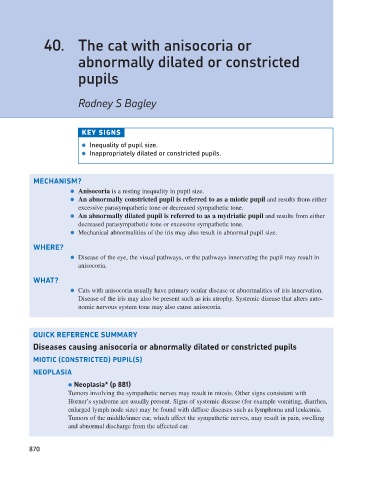Page 878 - Problem-Based Feline Medicine
P. 878
40. The cat with anisocoria or
abnormally dilated or constricted
pupils
Rodney S Bagley
KEY SIGNS
● Inequality of pupil size.
● Inappropriately dilated or constricted pupils.
MECHANISM?
● Anisocoria is a resting inequality in pupil size.
● An abnormally constricted pupil is referred to as a miotic pupil and results from either
excessive parasympathetic tone or decreased sympathetic tone.
● An abnormally dilated pupil is referred to as a mydriatic pupil and results from either
decreased parasympathetic tone or excessive sympathetic tone.
● Mechanical abnormalities of the iris may also result in abnormal pupil size.
WHERE?
● Disease of the eye, the visual pathways, or the pathways innervating the pupil may result in
anisocoria.
WHAT?
● Cats with anisocoria usually have primary ocular disease or abnormalities of iris innervation.
Disease of the iris may also be present such as iris atrophy. Systemic disease that alters auto-
nomic nervous system tone may also cause anisocoria.
QUICK REFERENCE SUMMARY
Diseases causing anisocoria or abnormally dilated or constricted pupils
MIOTIC (CONSTRICTED) PUPIL(S)
NEOPLASIA
● Neoplasia* (p 881)
Tumors involving the sympathetic nerves may result in miosis. Other signs consistent with
Horner’s syndrome are usually present. Signs of systemic disease (for example vomiting, diarrhea,
enlarged lymph node size) may be found with diffuse diseases such as lymphoma and leukemia.
Tumors of the middle/inner ear, which affect the sympathetic nerves, may result in pain, swelling
and abnormal discharge from the affected ear.
870

